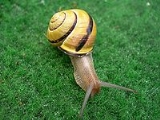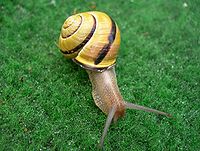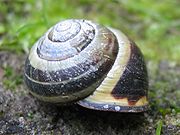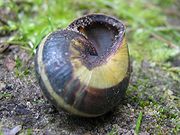
Grove snail
Encyclopedia
The grove snail or brown-lipped snail (Cepaea nemoralis) is a species
of air-breathing land snail
, a terrestrial
pulmonate gastropod mollusc. It is one of the most common species of land snail in Europe
and has been introduced to North America
.
Cepaea nemoralis is the type species of the genus Cepaea.
It is used as a model organism
in citizen science
projects.
of Cepaea nemoralis is very variable, reddish, brownish, yellow or whitish, with or without dark brown colour bands. Apertural lip usually dark brown, rarely white. The umbilicus is narrow but open in juveniles, closed in adults. For every colour variant names were established in the 1800s; this was later abandoned. The surface of the shell is semi-glossy, and it has from 4½ to 5½ whorls
.
The width of the shell is 18–25 mm. The height of the shell is 12–22 mm.
The animal is moderately slow and not very shy. In Haus der Natur Cismar this species is used to demonstrate snail behaviour to children.
Similar species:
in their shell colour and banding. The background colour of the shell can sometimes be so pale as to be almost white; it can also be yellow, pink, chestnut through to dark brown, and the shells can be with or without dark bandings. The bands vary in intensity of color, in width and in total number, from zero up to a total of six.
These polymorphisms have been highly studied as part research in heredity
and evolution
. They are thought to act as camouflage
to avoid predation from, for example, the Song Thrush
, but also have implications for the body heat of the animal: darker shells heat up more quickly, with consequences for rates of metabolism and loss of moisture (crucial in snail locomotion). In particular, grove snails with dark brown appear to preferentially be found in dark woodlands, whilst snails with light yellow shells and thin banding are more commonly found in grassland.
Different coloration and banding of the shells of Cepaea nemoralis:
 Its native distribution is from northern and western Europe to central Europe:
Its native distribution is from northern and western Europe to central Europe:
Western Europe:
Central Europe:
Southern Europe:
Northern Europe:
Eastern Europe:
No doubt aided by human transport, it is a good colonizer, and is often found in gardens, parks and abandoned land in cities. In eastern Europe it occurs in urban areas. More recently, the grove snail has been introduced to North America, and has established itself in various places. Also in Venezuela.
The white-lipped snail has a similar range, but that species extends further north to border the Arctic
.
 It is a very common and widespread species in the Western Europe, occupying a very wide range of habitats from dunes along the coast to woodlands with full canopy cover. It lives in shrubs and open woods in plains and highlands, dunes, cultivated habitats, gardens and roadsides. It can be found up to 1200 m in the Alps, 1800 m in the Pyrenees, 900 m in Wales, 600 m in Scotland.
It is a very common and widespread species in the Western Europe, occupying a very wide range of habitats from dunes along the coast to woodlands with full canopy cover. It lives in shrubs and open woods in plains and highlands, dunes, cultivated habitats, gardens and roadsides. It can be found up to 1200 m in the Alps, 1800 m in the Pyrenees, 900 m in Wales, 600 m in Scotland.
It feeds mainly on dead or senescent plants. It is not noxious to crops.
Like most Pulmonate land snails, it is hermaphrodite
and must mate to produce fertile eggs. Mating tends to be concentrated in late spring and early summer, though it can continue through the autumn. The snails often store the sperm they receive from their partner for some time, and individual broods can have mixed paternity. In Britain is lays clutches of 30-50 (in France 40-80) oval eggs are laid between June and August (in France May-October, in W France until November). The size of the egg is 3.1 × 2.6 mm or egg diameter can be 2.3-3.0 mm. Juveniles hatch after 15-20 days. Maturity is reached after shell is fully grown, in France after 1 year. It is comparatively slow-growing, usually taking three years to develop from egg to breeding adult. Life-span is up to 7-8 years, annual survival rates at about 50 % (= 3 % in 5 years, older adults suffer higher mortalities). In winter, the snails may hibernate, but can be active in warm spells.
Parasites:
Predators of Cepaea nemoralis include the Song Thrush
Turdus philomelos and others.
Species
In biology, a species is one of the basic units of biological classification and a taxonomic rank. A species is often defined as a group of organisms capable of interbreeding and producing fertile offspring. While in many cases this definition is adequate, more precise or differing measures are...
of air-breathing land snail
Land snail
A land snail is any of the many species of snail that live on land, as opposed to those that live in salt water and fresh water. Land snails are terrestrial gastropod mollusks that have shells, It is not always an easy matter to say which species are terrestrial, because some are more or less...
, a terrestrial
Terrestrial animal
Terrestrial animals are animals that live predominantly or entirely on land , as compared with aquatic animals, which live predominantly or entirely in the water , or amphibians, which rely on a combination of aquatic and terrestrial habitats...
pulmonate gastropod mollusc. It is one of the most common species of land snail in Europe
Europe
Europe is, by convention, one of the world's seven continents. Comprising the westernmost peninsula of Eurasia, Europe is generally 'divided' from Asia to its east by the watershed divides of the Ural and Caucasus Mountains, the Ural River, the Caspian and Black Seas, and the waterways connecting...
and has been introduced to North America
North America
North America is a continent wholly within the Northern Hemisphere and almost wholly within the Western Hemisphere. It is also considered a northern subcontinent of the Americas...
.
Cepaea nemoralis is the type species of the genus Cepaea.
It is used as a model organism
Model organism
A model organism is a non-human species that is extensively studied to understand particular biological phenomena, with the expectation that discoveries made in the organism model will provide insight into the workings of other organisms. Model organisms are in vivo models and are widely used to...
in citizen science
Citizen science
Citizen science is a term used for the systematic collection and analysis of data; development of technology; testing of natural phenomena; and the dissemination of these activities by researchers on a primarily avocational basis...
projects.
Description
Cepaea nemoralis is among the largest and because of its polymorphism and bright colours one of the most easily identified snails in Western Europe. The color of the shellGastropod shell
The gastropod shell is a shell which is part of the body of a gastropod or snail, one kind of mollusc. The gastropod shell is an external skeleton or exoskeleton, which serves not only for muscle attachment, but also for protection from predators and from mechanical damage...
of Cepaea nemoralis is very variable, reddish, brownish, yellow or whitish, with or without dark brown colour bands. Apertural lip usually dark brown, rarely white. The umbilicus is narrow but open in juveniles, closed in adults. For every colour variant names were established in the 1800s; this was later abandoned. The surface of the shell is semi-glossy, and it has from 4½ to 5½ whorls
Whorl (mollusc)
A whorl is a single, complete 360° revolution or turn in the spiral growth of a mollusc shell. A spiral configuration of the shell is found in of numerous gastropods, but it is also found in shelled cephalopods including Nautilus, Spirula and the large extinct subclass of cephalopods known as the...
.
The width of the shell is 18–25 mm. The height of the shell is 12–22 mm.
The animal is moderately slow and not very shy. In Haus der Natur Cismar this species is used to demonstrate snail behaviour to children.
 |
 |
Similar species:
- Cepaea vindobonensisCepaea vindobonensisCepaea vindobonensis is a species of medium-sized air-breathing land snail, a terrestrial pulmonate gastropod in the family Helicidae.The scientific name is derived from the Celtic settlement Vindobona, now known as Vienna, the capital of Austria....
is less intensively coloured. - Cepaea nemoralis differs from Cepaea hortensis usually by its dark lip. In areas where lip colour is variable, dissection is necessary. Cross-section of love dartLove dartA love dart is a hard, long, sharp, calcareous or chitinous dart which some hermaphroditic land snails and slugs create. Love darts are made in sexually mature animals only, and are used as part of the sequence of events during courtship, before actual mating takes place...
s shows a cross with simple blades, Cepaea hortensis has bifurcated blades. Cepaea hortensis has 4 or more branches of body light with reddish or brownish hue, upper side often slightly darker, tentacles darker and 15 mm long. Cepaea nemoralis is closely related to the white-lipped snailWhite-lipped snailThe white-lipped snail is a medium-sized species of air-breathing land snail, a terrestrial pulmonate gastropod mollusc...
, Cepaea hortensis, and shares much the same habitat. The grove snail is usually the larger of the two species when mature, but the principal difference is that the adult grove snail almost always has a dark brown lip to its shell, whilst adults of Cepaea hortensis almost always have a white lip. However, this distinguishing feature is not entirely reliable, as there is at least one morph of the grove snail which also has a white lip. When the identity of an adult individual is questionable, and it is necessary to distinguish the two species, a dissection can be used in order to examine the anatomy: the structure of the love dartLove dartA love dart is a hard, long, sharp, calcareous or chitinous dart which some hermaphroditic land snails and slugs create. Love darts are made in sexually mature animals only, and are used as part of the sequence of events during courtship, before actual mating takes place...
is quite different in the two species, as are the vaginal mucus glands.
Coloration
Apart from the band at the lip of the shell, grove snails are highly polymorphicPolymorphism (biology)
Polymorphism in biology occurs when two or more clearly different phenotypes exist in the same population of a species — in other words, the occurrence of more than one form or morph...
in their shell colour and banding. The background colour of the shell can sometimes be so pale as to be almost white; it can also be yellow, pink, chestnut through to dark brown, and the shells can be with or without dark bandings. The bands vary in intensity of color, in width and in total number, from zero up to a total of six.
These polymorphisms have been highly studied as part research in heredity
Heredity
Heredity is the passing of traits to offspring . This is the process by which an offspring cell or organism acquires or becomes predisposed to the characteristics of its parent cell or organism. Through heredity, variations exhibited by individuals can accumulate and cause some species to evolve...
and evolution
Evolution
Evolution is any change across successive generations in the heritable characteristics of biological populations. Evolutionary processes give rise to diversity at every level of biological organisation, including species, individual organisms and molecules such as DNA and proteins.Life on Earth...
. They are thought to act as camouflage
Camouflage
Camouflage is a method of concealment that allows an otherwise visible animal, military vehicle, or other object to remain unnoticed, by blending with its environment. Examples include a leopard's spotted coat, the battledress of a modern soldier and a leaf-mimic butterfly...
to avoid predation from, for example, the Song Thrush
Song Thrush
The Song Thrush is a thrush that breeds across much of Eurasia. It is also known in English dialects as throstle or mavis. It has brown upperparts and black-spotted cream or buff underparts and has three recognised subspecies...
, but also have implications for the body heat of the animal: darker shells heat up more quickly, with consequences for rates of metabolism and loss of moisture (crucial in snail locomotion). In particular, grove snails with dark brown appear to preferentially be found in dark woodlands, whilst snails with light yellow shells and thin banding are more commonly found in grassland.
Different coloration and banding of the shells of Cepaea nemoralis:
Distribution

Western Europe:
- Ireland
- Great Britain. It is rare and scattered in northern Scotland and is is obviously introduced there. (It does not live on the HebridesHebridesThe Hebrides comprise a widespread and diverse archipelago off the west coast of Scotland. There are two main groups: the Inner and Outer Hebrides. These islands have a long history of occupation dating back to the Mesolithic and the culture of the residents has been affected by the successive...
, Orkney or Shetland.) It seems to have been affected by air pollutionAir pollutionAir pollution is the introduction of chemicals, particulate matter, or biological materials that cause harm or discomfort to humans or other living organisms, or cause damage to the natural environment or built environment, into the atmosphere....
and soil acidificationSoil acidificationSoil acidification is the buildup of hydrogen cations, also called protons, reducing the soil pH. This happens when a proton donor is added to the soil. The donor can be an acid, such as nitric acid and sulfuric acid . It can also be a compound such as aluminium sulfate, which reacts in the soil to...
in some parts of England. - France
- Netherlands
- Switzerland
Central Europe:
- Austria
- Germany
- in the east to northwestern Poland
- Czech Republic - least concernLeast ConcernLeast Concern is an IUCN category assigned to extant taxon or lower taxa which have been evaluated but do not qualify for any other category. As such they do not qualify as threatened, Near Threatened, or Conservation Dependent...
(LC) - SW Hungary
Southern Europe:
Northern Europe:
- in the north to southern Sweden
Eastern Europe:
- Latvia
- Kaliningrad
- Estonia (HiiumaaHiiumaaHiiumaa is the second largest island belonging to Estonia. It is located in the Baltic Sea, north of the island of Saaremaa, a part of the West Estonian archipelago. Its largest town is Kärdla.-Name:...
island)
No doubt aided by human transport, it is a good colonizer, and is often found in gardens, parks and abandoned land in cities. In eastern Europe it occurs in urban areas. More recently, the grove snail has been introduced to North America, and has established itself in various places. Also in Venezuela.
The white-lipped snail has a similar range, but that species extends further north to border the Arctic
Arctic
The Arctic is a region located at the northern-most part of the Earth. The Arctic consists of the Arctic Ocean and parts of Canada, Russia, Greenland, the United States, Norway, Sweden, Finland, and Iceland. The Arctic region consists of a vast, ice-covered ocean, surrounded by treeless permafrost...
.
Ecology

It feeds mainly on dead or senescent plants. It is not noxious to crops.
Like most Pulmonate land snails, it is hermaphrodite
Hermaphrodite
In biology, a hermaphrodite is an organism that has reproductive organs normally associated with both male and female sexes.Many taxonomic groups of animals do not have separate sexes. In these groups, hermaphroditism is a normal condition, enabling a form of sexual reproduction in which both...
and must mate to produce fertile eggs. Mating tends to be concentrated in late spring and early summer, though it can continue through the autumn. The snails often store the sperm they receive from their partner for some time, and individual broods can have mixed paternity. In Britain is lays clutches of 30-50 (in France 40-80) oval eggs are laid between June and August (in France May-October, in W France until November). The size of the egg is 3.1 × 2.6 mm or egg diameter can be 2.3-3.0 mm. Juveniles hatch after 15-20 days. Maturity is reached after shell is fully grown, in France after 1 year. It is comparatively slow-growing, usually taking three years to develop from egg to breeding adult. Life-span is up to 7-8 years, annual survival rates at about 50 % (= 3 % in 5 years, older adults suffer higher mortalities). In winter, the snails may hibernate, but can be active in warm spells.
Parasites:
- Cepaea nemoralis it is known experimental (only experimental?) host for Angiostrongylus vasorumAngiostrongylus vasorumAngiostrongylus vasorum, also known as French heartworm, is a species of parasitic nematode in the family Metastrongylidae. It causes the disease canine angiostrongylosis in dogs.Not much is known about the biology of this species.- Description :...
.
Predators of Cepaea nemoralis include the Song Thrush
Song Thrush
The Song Thrush is a thrush that breeds across much of Eurasia. It is also known in English dialects as throstle or mavis. It has brown upperparts and black-spotted cream or buff underparts and has three recognised subspecies...
Turdus philomelos and others.

